When it comes to farming, one of the primary concerns is making sure your animals are well taken care of, and goats are no exception. Whether you’re raising them for milk, meat, or simply as companions, building a proper goat shelter is one of the best investments you can make. But what if you’re on a budget? How do you ensure your goats have a safe and comfortable shelter without breaking the bank? This is where Cheap Goat Shelter Plans for Small Farms come into play, offering cost-effective solutions that don’t compromise on quality or protection.
In this in-depth guide, we’ll explore everything you need to know about constructing cheap goat shelter plans for small farms. From understanding why a shelter is essential to choosing the right materials, we’ll cover every aspect of building a cheap goat shelter that is durable, practical, and budget-friendly.
Here’s a table with key facts and figures to help guide you when building a cheap goat shelter for your small farm. These numbers will give you a better understanding of the space requirements, materials, and shelter sizes needed for a functional and budget-friendly shelter.
| Category | Details/Recommendations |
|---|---|
| Shelter Size | |
| 1 Goat (Small Breed) | 8-10 sq. ft per goat (e.g., Nigerian Dwarf) |
| 3-4 Goats | 32 sq. ft for 3-4 goats (Small breeds) |
| 6-8 Goats | 48-64 sq. ft for 6-8 goats (Small breeds) |
| Flooring Options | |
| Dirt Floor | Cost: Low; Maintenance: Medium; Pros: Good drainage |
| Plywood Subfloor | Cost: Low-Medium; Maintenance: High (needs sealing); Pros: Durable |
| Linoleum or Vinyl Flooring | Cost: Medium; Maintenance: Low; Pros: Easy to clean, durable |
| Materials for Shelter | |
| Pallets | Cost: Low (Free/Low if found locally); Durability: Medium |
| Plywood | Cost: Medium; Durability: High |
| Corrugated Metal | Cost: Moderate; Durability: High (long-lasting and weather-resistant) |
| Straw Bales | Cost: Low; Uses: Insulation, bedding |
| Insulation Materials | |
| Straw Bales | Cost: Low; Uses: Insulating walls, floors |
| Foam Board | Cost: Medium; Uses: Wall insulation, helps maintain warmth |
| Goat Shelter Placement | |
| Proximity to Water Source | Ideal: Less than 100 feet |
| Windbreak or Protection | Preferred: Shelter placed near trees or a fence for wind protection |
| Ventilation | |
| Vents/Windows | Size: Small; Placement: Near roof for airflow |
| Winter Shelter Features | |
| Insulated Walls | Material: Straw bales, foam board |
| Slanted Roof | Ideal Pitch: 20-30 degrees to help snow/rain runoff |
| Shelter for 3-4 Goats | |
| Shelter Size | 8×10 ft minimum; ideal for 3-4 goats |
| Costs | |
| Pallet Shelter | Cost: Approx. $100-200 (depending on material sourcing) |
| Plywood Shelter | Cost: Approx. $200-300 (based on plywood prices) |
| Corrugated Metal Shelter | Cost: Approx. $250-400 (for a 10×12 ft shelter) |
Why Is It Important to Have a Proper Goat Shelter?
Goats, like all farm animals, need a safe and comfortable environment to thrive. While goats are often thought of as hardy animals that can withstand a variety of conditions, they are still susceptible to the elements, predators, and health problems that can arise from a lack of shelter. Let’s look at some of the key reasons why providing your goats with a proper shelter is so important.
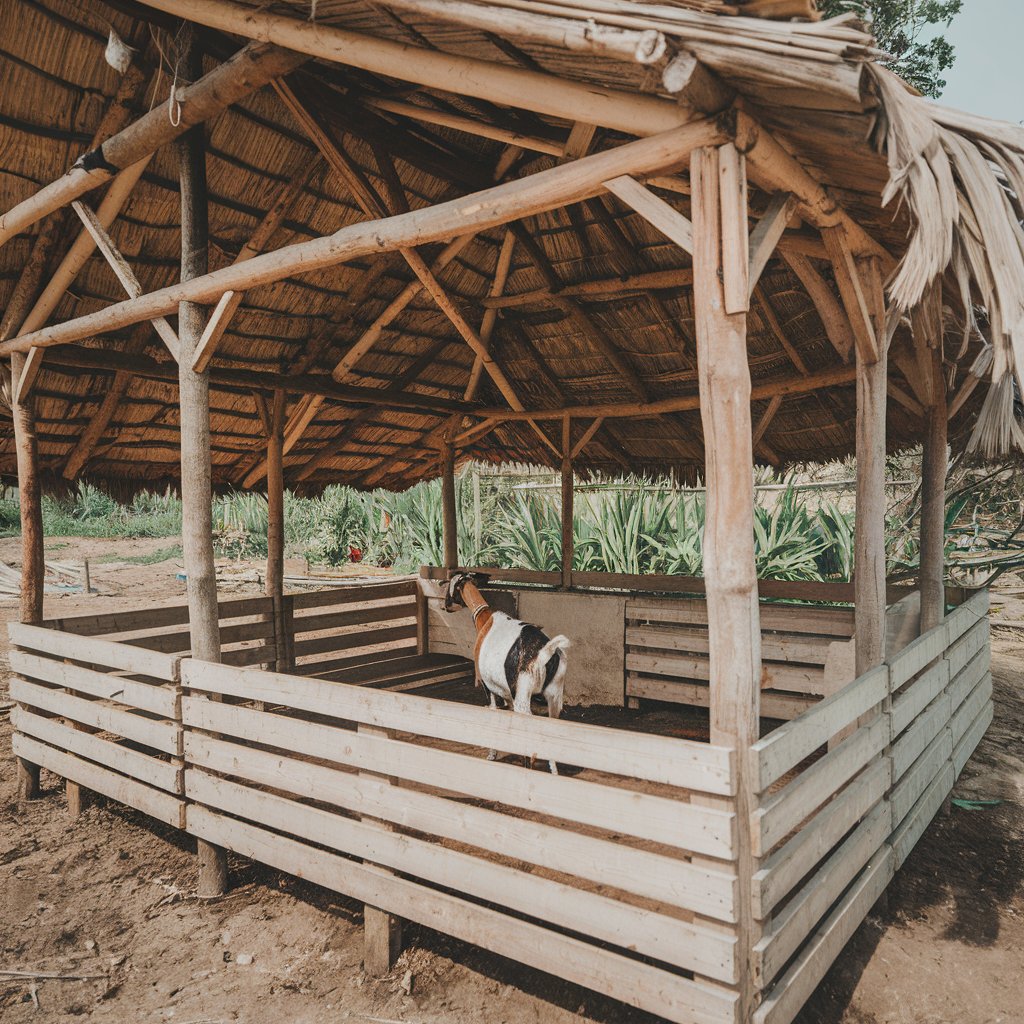
Protection from the Elements
Goats are hardy animals, but extreme weather conditions can still affect their health. Whether it’s sweltering heat in the summer or freezing temperatures in the winter, goats need protection. A goat shelter ensures they are shielded from the elements, allowing them to stay comfortable and healthy no matter the season.
- Winter: During the colder months, goats need protection from wind, snow, and rain. Without shelter, they risk hypothermia, frostbite, and respiratory infections. A properly insulated shelter with proper ventilation can keep them warm and safe.
- Summer: In hot weather, goats can become overheated, especially if they don’t have access to shade. A well-ventilated shelter helps keep the air moving, providing them with a cooler, more comfortable environment.
Health and Hygiene
Goats are clean animals by nature, but they require a dry, clean space to live. If their shelter is wet or muddy, they can easily become susceptible to diseases, hoof problems, or parasites. A dry and well-maintained shelter will promote their overall health and reduce the risk of illnesses.
Security from Predators
Whether you’re raising goats in rural areas or on a more urban farm, predators are a constant threat. Goats are easy prey for animals such as coyotes, dogs, and even birds of prey. A sturdy shelter with secure walls, doors, and roofs can keep your goats safe from these threats.
Materials for Building Goat Shelters
Choosing the right materials is crucial when building a cheap goat shelter. You want materials that are affordable but durable enough to withstand both the elements and the wear and tear of daily use. Fortunately, there are several inexpensive materials that can work wonders for a goat shelter.
Common Materials for Goat Shelters
- Pallets: One of the most cost-effective options for building a goat shelter is using pallets. These can often be found for free at construction sites, warehouses, or local businesses. Pallets are sturdy and can be used for walls, floors, and even roofing. You’ll need to treat them to ensure they last, especially if they’ll be exposed to moisture.
- Plywood: Plywood is another affordable material for shelter construction. It’s strong, easy to work with, and can be used for constructing walls, floors, and even the roof of your goat shelter. It’s also relatively inexpensive and can be found at most home improvement stores.
- Corrugated Metal: For roofing, corrugated metal is a durable, low-cost option. It sheds water and snow easily and provides excellent protection from the elements. Corrugated metal is relatively lightweight but strong enough to stand up to wind and rain. It also has the benefit of being long-lasting and relatively low maintenance.
- Tarp: If you’re building a temporary or mobile shelter, a tarp is a great material to use. It’s lightweight, affordable, and easy to install. However, it won’t provide as much insulation or protection as other materials, so it’s best suited for short-term or less harsh environments.
- Straw Bales: Straw bales can be used as an insulating material in the walls or as part of the shelter’s construction. They are relatively inexpensive and provide natural insulation against the cold. In addition, straw bales create a warm, cozy space for your goats during the winter months.
- Recycled Materials: Another great way to save on shelter costs is by using recycled materials. Old doors, windows, or even pieces of a dilapidated shed can be repurposed into a goat shelter. This not only saves money but also helps reduce waste, making it an environmentally friendly option.
| Material | Cost | Durability | Best Use |
|---|---|---|---|
| Pallets | Free/Low | Medium | Walls, Floors, Small Roofs |
| Plywood | Low | High | Walls, Floors, Roofing |
| Corrugated Metal | Moderate | High | Roofs, Walls |
| Tarp | Low | Low/Medium | Temporary Roofs and Walls |
| Straw Bales | Low | High (with insulation) | Insulation, Walls |
Flooring Options for Goat Shelters
The flooring of your goat shelter is just as important as the walls and roof. The floor needs to be safe, comfortable, and easy to clean. Here are some of the most common flooring options for a cheap goat shelter:
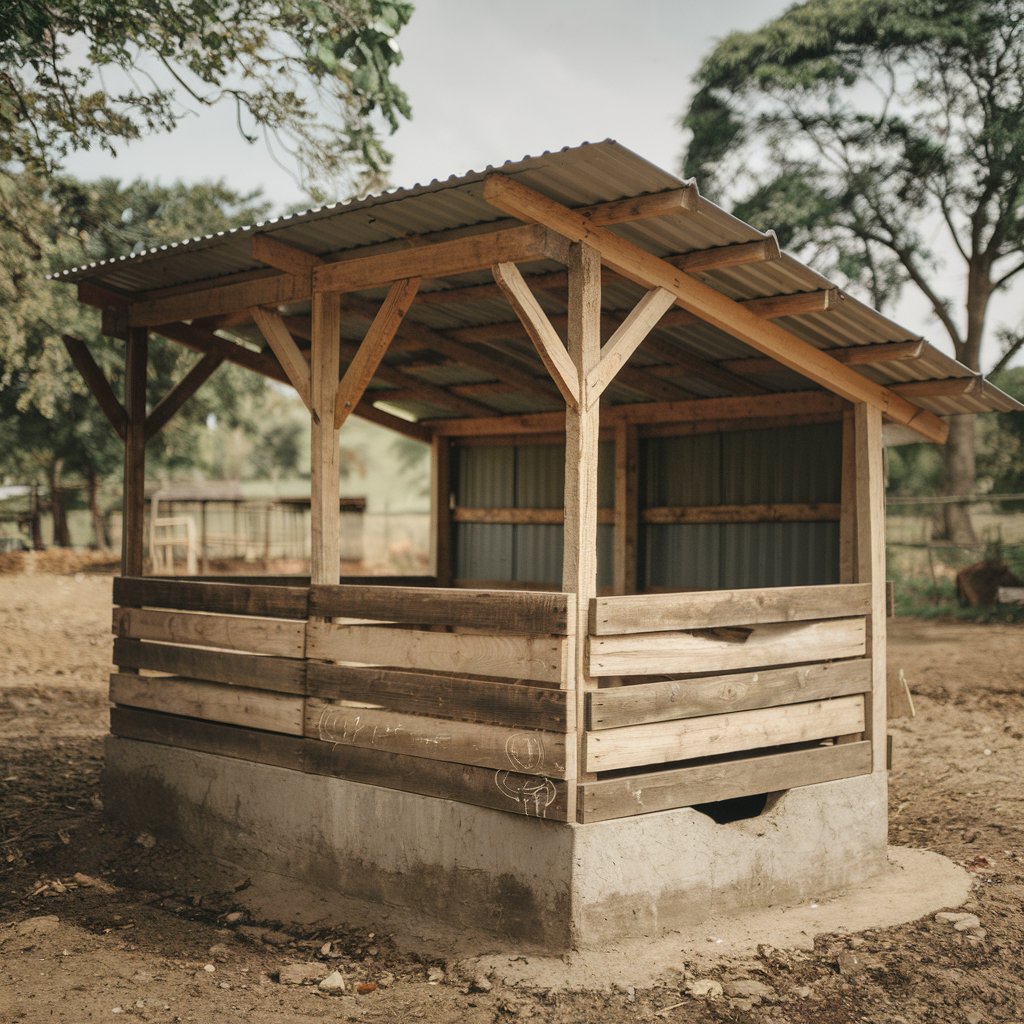
Dirt Floors
One of the most affordable flooring options is using the natural dirt already present on your property. Dirt floors are excellent for drainage, preventing water from pooling inside the shelter, which can lead to health problems. Goats generally don’t mind dirt floors, and they help maintain a more natural environment. However, they can become muddy in wet weather, so you may want to add some straw or bedding for extra comfort.
Wood Subfloors
If you prefer a more structured floor, wooden subfloors are another great choice. You can use pressure-treated lumber to build a simple wooden floor. This is especially useful if your goats will spend a lot of time indoors. However, keep in mind that wood can rot over time, especially in damp conditions, so it’s important to maintain the floor by keeping it clean and dry.
Linoleum or Vinyl Flooring
For a low-maintenance, easy-to-clean option, consider using linoleum or vinyl. These materials are both durable and affordable, and they can withstand the wear and tear of goat hooves. They also make cleaning easier, as waste and spilled feed can be wiped up easily.
Bedding
No matter what type of floor you choose, your goats will need bedding for comfort and cleanliness. Straw, wood shavings, and sawdust are all excellent bedding options. They absorb moisture, help maintain a dry environment, and provide a soft surface for your goats to lie on.
Where to Place Your Goat Shelter
The location of your goat shelter is just as important as its design and materials. Placing the shelter in the right spot will help ensure your goats have a comfortable and healthy living environment.
Key Location Considerations
- Proximity to Water: Make sure your shelter is close to a reliable water source. Goats need fresh water daily, so you’ll want to keep their shelter near a water trough or natural source.
- Ventilation: Adequate ventilation is crucial, especially in the warmer months. A shelter that doesn’t allow air to flow freely can become too hot and stuffy, which could harm your goats. Opt for a location with good airflow or include windows or vents in your shelter design.
- Wind Protection: In colder climates, it’s essential to place your shelter in an area that’s shielded from harsh winds. Planting trees or building a windbreak can provide natural protection.
- Avoid Wet Areas: Be sure to place your shelter in an area that is not prone to flooding or waterlogging. A wet environment can lead to muddy conditions and increase the risk of health problems for your goats.
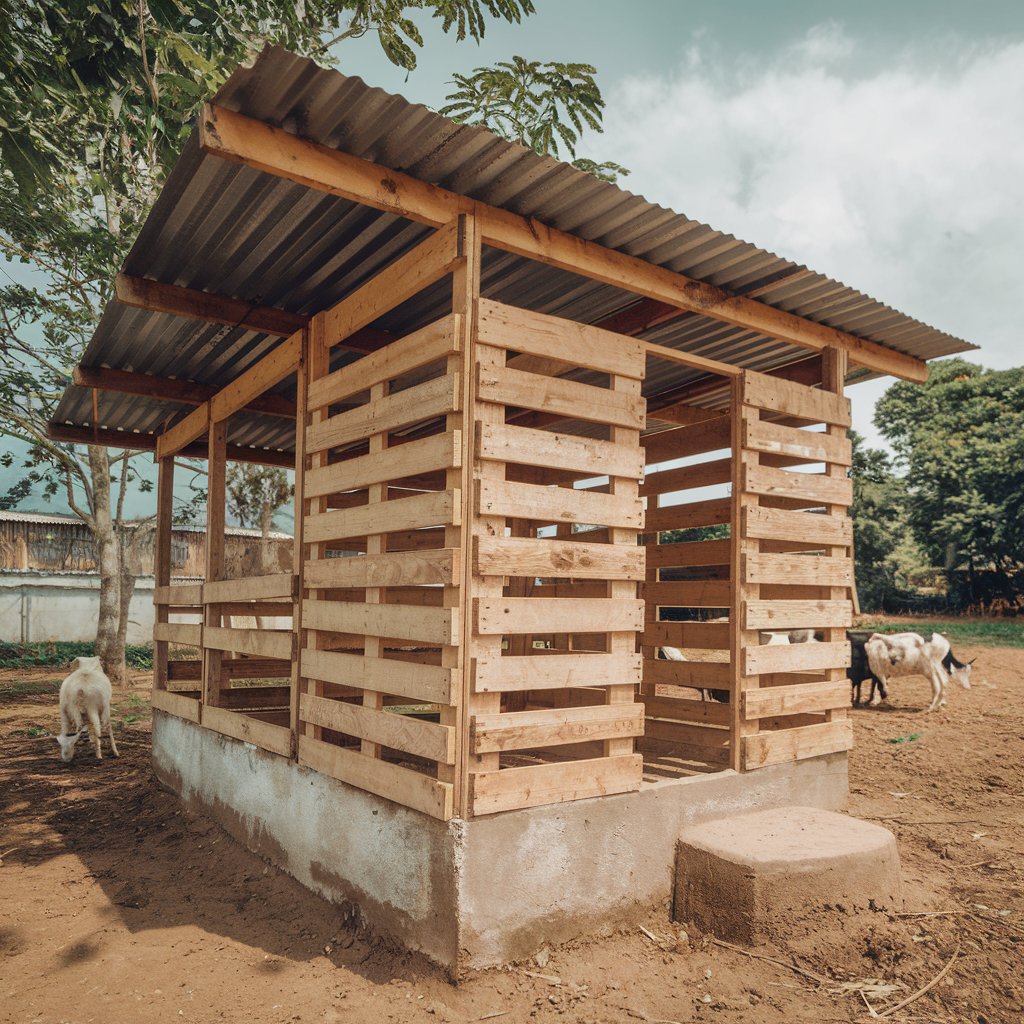
Can Goats Share a Shelter with Other Animals?
In small farm settings, it’s common to house multiple types of animals together. But can goats share their shelter with other farm animals? While some animals get along well with goats, others can create conflicts. Here’s a guide to which animals can safely cohabitate with goats in the same shelter.
Compatible Animals
- Sheep: Goats and sheep can share a shelter with minimal issues. Both animals have similar needs when it comes to space, food, and shelter. Just ensure that there’s enough room for both species to move around freely.
- Chickens: Goats and chickens can cohabit, but they should have separate spaces. Goats will likely eat the chickens’ feed, and chickens may become harmed by goat hooves. Keeping their food and bedding areas separate within the shelter will help prevent these issues.
- Donkeys and Horses: Donkeys are known to be excellent protectors for goats. They help keep predators at bay, making them an ideal companion for goats. Horses can also share a shelter with goats, though the shelter will need to be large enough for both animals to have adequate space.
Potential Challenges
- Feeding Conflicts: Goats have a tendency to eat everything in sight, including other animals’ food. Keeping their feed in a separate area within the shelter can prevent this problem.
- Space: Overcrowding can lead to stress and aggression, so always ensure that there is enough space for each animal to feel comfortable.
DIY Goat Shelter Plans
If you’re handy with tools and want to save even more money, building your own DIY goat shelter can be a great option. Here are a few ideas for simple, cheap goat shelter plans you can try:
Winter Goat Shelter Plan (10×12)
For those living in colder climates, a 10×12 winter shelter plan is an excellent option. This design includes insulation in the walls and roof, ensuring that your goats stay warm during the harsh winter months. You can use straw bales, foam board, or even recycled insulation to keep the shelter cozy. Make sure to include proper ventilation to prevent moisture buildup.
Compact Shelter Plan (8×10)
An 8×10 shelter is a great option for a small herd. It’s compact yet spacious enough to accommodate 2-4 goats comfortably. Using affordable materials like pallets and plywood, you can create a sturdy and functional shelter that provides protection from the elements.
A-Frame Shelter Plan
The A-frame design is a simple yet effective way to build a cheap goat shelter. This style allows for easy construction with pallets, plywood, or corrugated metal for the roof. The slanted roof helps shed snow and rain, while the open sides allow for airflow.
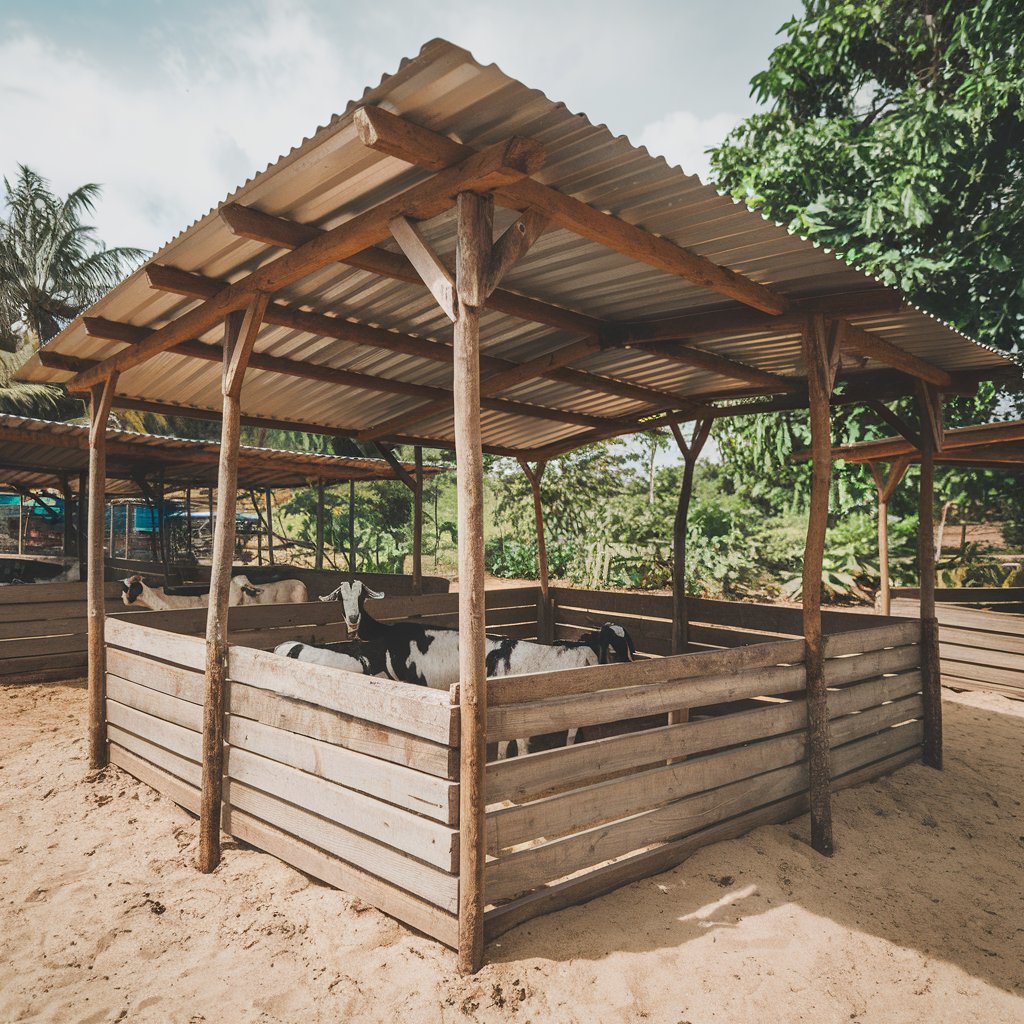
Maintenance and Durability Tips
A cheap goat shelter may be easy to build, but it still requires maintenance to ensure it lasts and provides adequate protection for your goats. Here are some maintenance tips:
Cleaning and Maintenance
- Regular Manure Removal: Goats are messy animals, so it’s essential to clean their shelter frequently. Remove manure at least once a week, and replace bedding regularly to maintain a clean environment.
- Check for Wear and Tear: Inspect the shelter regularly for any signs of damage, such as broken boards or a leaky roof. Repair these issues promptly to prevent further damage.
Durability
- Weatherproofing: Use weather-resistant materials such as corrugated metal or treated plywood to extend the life of your shelter. These materials can withstand rain, wind, and snow better than untreated wood.
- Insulation: Proper insulation is key to keeping your goats warm in winter and cool in summer. Make sure your shelter has adequate insulation, whether it’s straw bales, foam board, or another material.
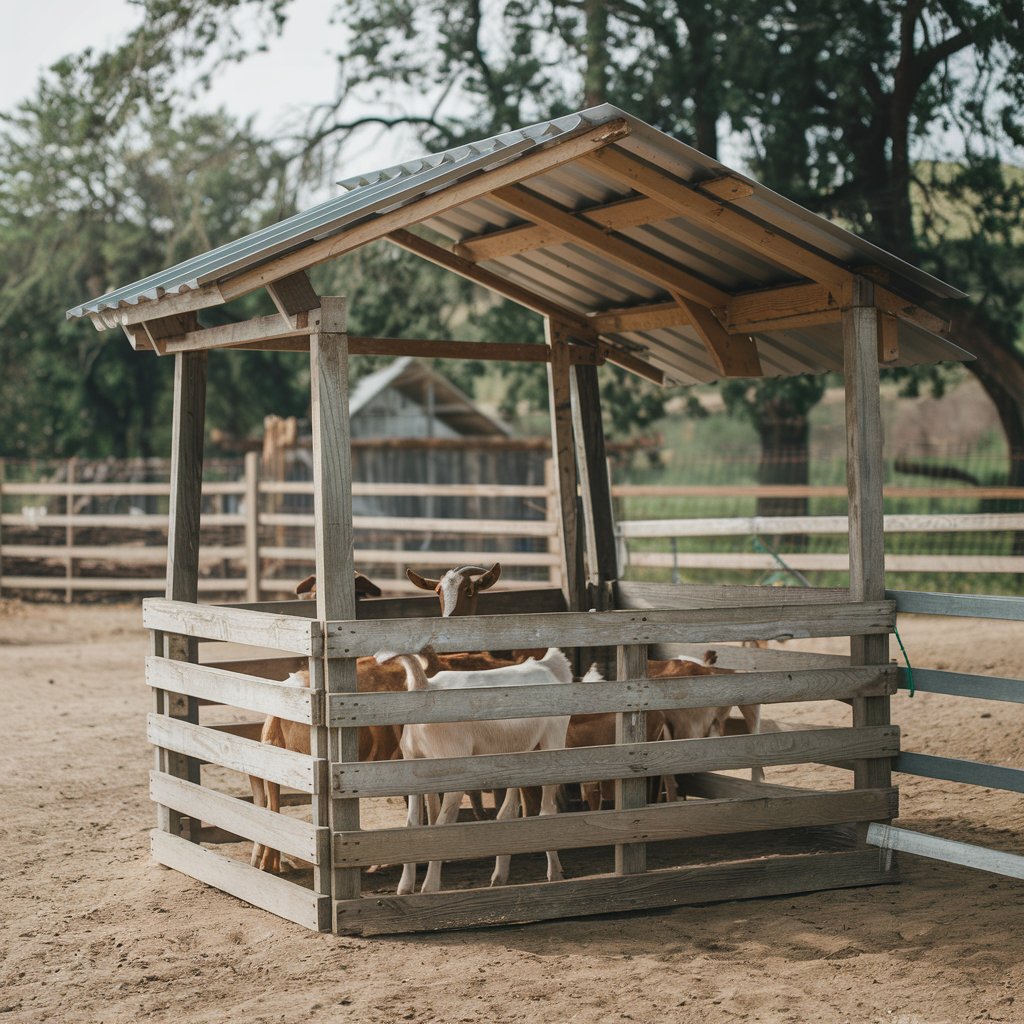
FAQs
What is the best shelter for goats?
Goats require formal shelter like a barn or three-sided shed for protection from heat or rain, but natural cover like trees or brush can suffice in mild conditions.
What can I use as a goat shelter?
A cost-effective shelter can be made using pallets secured together to create walls and a roof, offering a basic but functional solution.
What is the best housing facility for goats?
Goat housing should feature a dry, well-drained floor, protection from harsh weather, and easy access to water and bedding maintenance.
How big should a goat shelter be?
Allow 16–25 square feet per goat, with 20 square feet being the ideal space to ensure comfort and room for movement.
What is the best bedding for goat shelter?
Wood chips, sawdust, or pine shavings are ideal for bedding as they provide insulation, reduce odors, and keep goats comfortable.
What is the best flooring for goats?
Dirt floors are a good option for goat housing as they offer better traction and cushioning, though they require regular maintenance for cleaning.
How much space do goats need?
Each doe requires at least 16 square feet for resting, plus 25–50 square feet for grazing, depending on the number of goats.
What helps a goat survive?
Goats survive due to their adaptive features like strong hooves for balance, wide-vision eyes to detect predators, and a four-chambered stomach for digesting tough food.
What do goats like to sleep on?
Goats enjoy sleeping on raised platforms like pallets, which keep them dry and off the ground away from urine.
What is the best environment for goats?
Goats thrive in warm, dry, and well-ventilated shelters that are free from drafts and provide comfort in all weather conditions.
What toys do goats like to play with?
Goats love interactive toys like plastic or metal drums and even enjoy sounds from recordings of other goats to keep them entertained.
How do you clean up goat poop?
Promptly remove goat poop, rinse the area, disinfect with a vinegar or bleach solution, and use stall fresheners to maintain a clean environment.
How to keep goats warm?
Feed goats roughage to generate internal heat, insulate their shelter, and ensure they stay active and hydrated to maintain warmth during cold months.
What size shelter do I need for my goats?
The shelter size should provide 8-10 square feet per goat; for 3-4 goats, aim for 32 square feet, and for 6-8 goats, 48-64 square feet is recommended.
Can I build a cheap goat shelter myself?
Yes, you can build an affordable shelter using repurposed materials like pallets, plywood, or corrugated metal to save costs.
What materials are best for building a goat shelter?
Wooden pallets, plywood, corrugated metal, and straw bales for insulation are budget-friendly and durable materials for building a goat shelter.
Do goats need to be protected from the weather?
Goats require protection from both cold and hot weather with insulated shelters in winter and well-ventilated spaces in summer.
Can I house other animals in the same shelter as my goats?
Goats can share a shelter with other animals like sheep or chickens, but each should have their own space to avoid conflicts.
What kind of flooring should I use in my goat shelter?
Dirt floors provide natural drainage, but plywood or linoleum offer more durability and easier cleaning, with bedding like straw for added comfort.
How do I ensure my goat shelter is predator-proof?
Use strong materials like metal or reinforced wood for the shelter, secure doors, and ensure there are no gaps that predators can exploit.
How much should I expect to spend on a cheap goat shelter?
A budget-friendly goat shelter made from pallets costs around $100-200, while more durable options like plywood or corrugated metal may range from $200-400.
Where is the best place to build a goat shelter?
Choose a location that’s accessible yet sheltered from strong winds, close to a water source, and near areas like gardens to easily use goat manure as fertilizer.
What are some easy-to-follow cheap goat shelter plans?
Plans using pallets, slanted roofs for runoff, and straw or foam board for insulation provide a simple, cost-effective solution for goat housing.
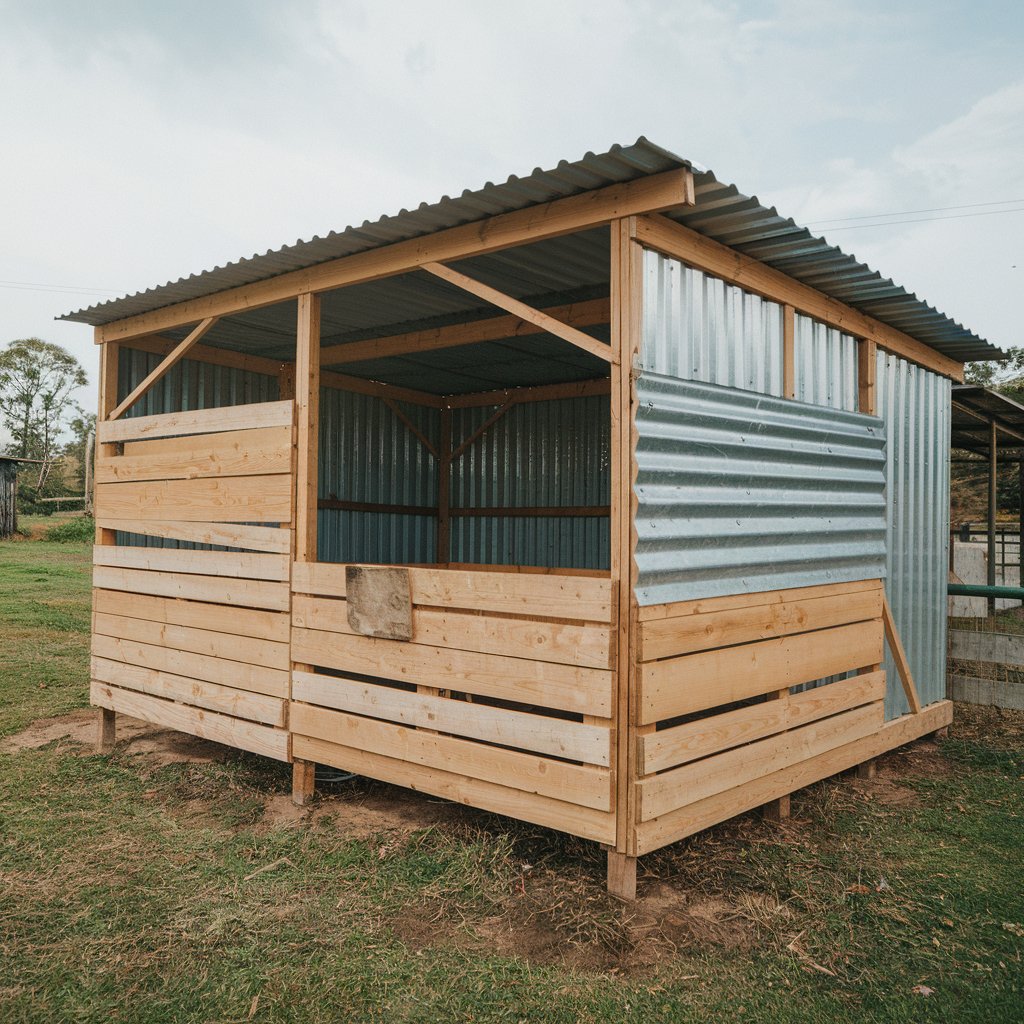
Conclusion: Building a Cheap Goat Shelter for Small Farms
Building a cheap goat shelter doesn’t mean sacrificing quality or safety. By using affordable materials like pallets, plywood, and corrugated metal, you can create a shelter that will protect your goats year-round. Whether you opt for a simple A-frame design or a more robust winter shelter plan, the important thing is to ensure your goats are comfortable, secure, and safe.
By following these DIY goat shelter plans and maintenance tips, you’ll have a durable, affordable home for your goats that will last for years. The key is careful planning, cost-effective material choices, and ongoing upkeep to ensure the shelter remains in great condition. Best of luck in building the perfect goat shelter for your small farm!
Read more knowledgeable blogs on Flowy Magazine

James Clair is a passionate writer and researcher with a deep fascination for animal behavior and its intricate connection to human life. With a background in [relevant field of study, e.g., zoology, psychology, ethology], James has spent years studying the natural world, focusing on how animals’ actions and instincts impact human emotions, behavior, and society.
His expertise in [specific topics or regions of focus, e.g., canine psychology, animal communication, wildlife conservation] has led to numerous published works and collaborations with renowned researchers and institutions. Through his work at Flawy Magazine, James aims to bridge the gap between scientific research and public understanding, offering insightful, accessible articles that explore the complex relationship between humans and animals.
When he’s not writing, James enjoys [personal hobbies or interests, e.g., hiking in nature, volunteering at animal shelters, photography] and is an advocate for [cause or charity related to animals or conservation]. His mission is to inspire readers to see animals not just as companions or creatures of the wild, but as beings whose behavior holds valuable lessons for us all.









